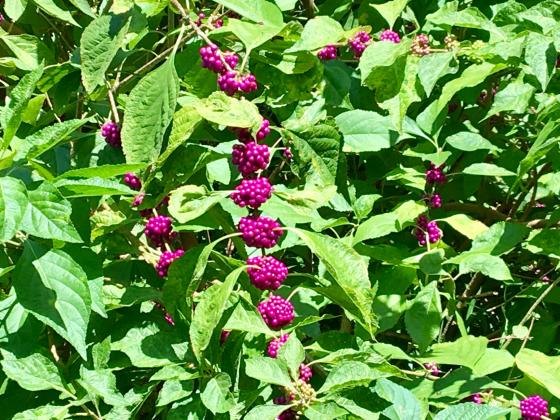
By: Rick Bogren, rbogren@agcenter.lsu.edu
Heather Kirk-Ballard, LSU AgCenter Horticulturist
American beautyberry (Callicarpa americana) is a native shrub of North America. It can be found growing naturally in southeastern woodlands and along the edges of forests from Oklahoma and Texas all through the South and on up into Maryland.
It can also be found growing natively in the Caribbean and northern Mexico. A plant with a rich history, American beautyberry can be found growing in low, rich bottomlands, at the edges of swamps, in piney woods and in coastal woodlands.
In Greek, the genus name Callicarpa means callos, “beauty,” and carpos, “fruit.” And of course, the species americana indicates its origins in America. It is also commonly known by the name French mulberry for reasons I cannot understand.
The plant is neither a mulberry nor natively French, but I digress. Nonetheless, many may know the plant by this name as well as sourberry.
This shrub is strikingly good-looking in late summer and into fall when it encircles its branches with beautiful purple berries. Otherwise inconspicuous flowers can be found in June to July. It is a great addition to the landscape for so many reasons.
Let’s start with its distinguishing characteristics. The plant is a deciduous (loses its leaves in winter) shrub that grows 4 to 8 feet tall (sometimes taller) by 4 to 6 feet wide. Its shape is open and airy with a loose, spreading form. It is not a dense shrub.
You can see through the open branches to other landscape features. It has beautiful elliptic-shaped, light green to yellow leaves that can be 3 to 6 inches long with toothed margins. This shrub displays a light pink flower in the summer, but it adds no major ornamental value to the landscape.
The fruit, however, is a totally different story. This shrub is called beautyberry just for that reason. Its beautiful, purple berrylike (drupe) fruit are spectacular.
They are most abundant when the shrub is located in full sun, and fruit will be sparse in the shade. It makes for a great understory shrub with a moderate-fast growth rate and requires little maintenance. It grows well in most soils — even poor, clay soils — and is considered be both drought tolerant and relatively pest-free. It has been known to get some leaf spot and black mold in some areas.
Beautyberry is considered a pioneer species in plant succession because it is often one of the first plants to appear in sunny, open areas on land that has been cleared, especially near the edges of forests, swamps, bottomlands and coastal wetlands.
This plant offers many ecosystem services. The seeds and berries are an important food source for many songbird species of America, including American robin, brown thrasher, northern bobwhite, purple finch and eastern towhee.
It is also an important food source for armadillo, foxes, possums, raccoons, squirrels and white-tailed deer.
Additionally, it is a nectar source for butterflies and has fragrant foliage. It is a wonderful choice for homeowners supporting native insects and wildlife.
Humans have also used the American beautyberry throughout history. Native Americans and early settlers used the roots, leaves and branches of the plants to treat ailments such as malarial fevers, rheumatism, sour stomach and dysentery.
The English naturalist Mark Catesby in the early 1700s sent American beautyberry specimens back to England, where it now continues to be grown in European gardens.
Farmers successfully used crushed beautyberry leaves in the early 20th century to repel biting bugs from mules and horses by rubbing it on their coats and under harnesses. People also rubbed crushed leaves on their skin as an insect repellant, as well. This folklore has continued to be passed down from generation to generation in some parts of the country.
The National Center for Natural Products Research at the University of Mississippi has put this folklore to the test and found in lab studies that there is some validity to its power to ward off ticks, ants and mosquitos.
The American beautyberry plant can be a great addition to the home landscape as a deciduous understory shrub with fall color interest and for its ecoservice benefits as a native food source for local wildlife and pollinators.
It is most notable for its seasonal color change and early autumn color and as an ornamental landscape plant here in Louisiana. It is available at most local nurseries and can be found growing wild (throughout Louisiana.
It can be a relatively short-lived shrub at about 10 to 15 years, but many volunteer plants can be found from seeds distributed by birds and squirrels — you will often find plants growing in colonies. They also are easily propagated by softwood cuttings.
Not much maintenance is required. American beautyberry can be heavily pruned before new growth begins in spring to control the size and shape of the shrub and to encourage new growth on older plant specimens.
Or it can be left to grow in its most native, spreading loose form that makes it so graceful and unique.
I love recommending native plants.
They just make good sense. And with a rich history such as this, we should carry on the tradition.
